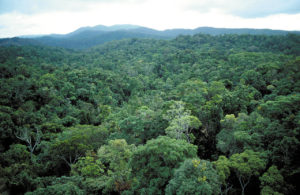Climate Change May Starve Bamboo Lemurs
As the climate changes and Madagascar’s dry season gets longer, endangered greater bamboo lemurs may be forced to eat less nutritious food, and could slowly starve.
 Image: By Rvb (Own work) [Public domain], via Wikimedia Commons
Image: By Rvb (Own work) [Public domain], via Wikimedia Commons Madagascar’s greater bamboo lemurs are one of the most endangered primate species on Earth. They eat, almost exclusively, a single species of bamboo, preferably the more nutritious and tender bamboo shoots. But when necessary, during the dry season, they use their specialised teeth to gnaw on the woody trunk, known as culm.
In a new study, published in Current Biology, researchers have provided evidence to suggest that, as the climate changes, greater bamboo lemurs will be forced to feed on the less nutritious culm for longer periods. Based on an analysis of anatomical, behavioural, paleontological and climate data, they suggest that ultimately the lemurs could slowly starve.
“For extreme feeding specialists like the greater bamboo lemur, climate change can be a stealthy killer,” says Patricia Wright at Stony Brook University, one of the authors. “Making the lemurs rely on a suboptimal part of their food for just a bit longer may be enough to tip the balance from existence to extinction.”
To find out more about the lemurs’ feeding habits, the researchers spent hours watching them in their natural habitat in Madagascar’s Ranomafana National Park for 18 months. More than 2,000 feeding observations showed that the lemurs spend 95% of their feeding time eating one particular species of woody bamboo. They only eat the culm from August to November, when the dry conditions make the tender shoots unavailable.
Analysis of the lemur’s current distribution, compared to its past one, revealed that they now live only in parts of the island where the dry season is relatively short. It appears that a short dry season has been crucial to the survival of greater bamboo lemurs in the past.
The bad news is that climate models suggest that the areas where the lemurs currently inhabit are likely to experience longer and longer dry seasons in the future. As this would force the lemurs to eat only the culm for longer periods, it could put their survival at risk.
These findings may have implications for understanding the fate of bamboo-feeding giant pandas, too. The Chinese icons are threatened by deforestation and changes in the distribution of bamboo. Yet this new data suggests that a changing climate may also threaten bamboo feeders in a more subtle way, by affecting the seasonal availability of preferred and more nutritious bamboo parts. Other animals with highly specialised diets may prove to be similarly vulnerable.
“By studying specialists like the greater bamboo lemur, we can identify the different ways that climate change can cause extinction,” says author Jukka Jernvall at University of Helsinki. “And if we do not study these endangered species now, they may go extinct before we know all the reasons why, and we’ll be less able to protect what remains.”
The researchers now hope that this new knowledge and understanding of the greater bamboo lemur, together with climate predictions, can be applied to building bamboo corridors – to connect isolated lemur populations and expand their habitats.





No comments yet.